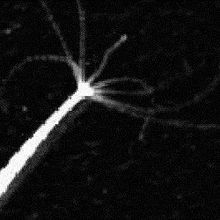cnidarian

With Neither Brains nor Brawn, Jellyfish and Relatives Developed Subcellular Weapons Instead
Hannah Thomasy, PhD | May 29, 2024 | 6 min read
Anna Klompen explained how cnidarian stinging cells harpooned their way into her heart and could help answer fundamental questions in biology.

Ancient Immunoglobulin Genes Help Cnidarians Decide to Fight or Fuse
Sophie Fessl, PhD | Oct 11, 2022 | 4 min read
Immunoglobulin genes might have evolved much earlier than previously expected, perhaps even in the common ancestor of Cnidarians and Bilateria, a study suggests.

Image of the Day: Color Grid
Chia-Yi Hou | Apr 26, 2019 | 1 min read
Researchers genetically engineered E. coli to produce colorful and fluorescent proteins originally from Cnidaria.

Image of the Day: Pretty Jellies
Chia-Yi Hou | Apr 19, 2019 | 1 min read
The genomes of jellyfish are compared with those of other Cnidarian species that don’t have a free-swimming stage.

Image of the Day: Squeeze In
Sukanya Charuchandra | Jul 30, 2018 | 1 min read
A novel system lets researchers examine the neuromuscular features of a hydra.

Image of the Day: Remodeled
Sukanya Charuchandra | Jun 25, 2018 | 1 min read
Researchers use CRISPR-Cas9 to create transgenic Hydractinia symbiolongicarpus, a cnidarian, for the first time.

Image of the Day: Spammed by Hydra
The Scientist and The Scientist Staff | May 1, 2018 | 1 min read
A junk mail filter can learn to pick out six behaviors of hydras by analyzing hours of video footage.

Sea Anemones Illuminate the Evolution of Embryo Development
Abby Olena, PhD | Sep 11, 2017 | 4 min read
A study of a simple marine animal suggests that the common ancestor of cnidarians and bilaterians may have had three germ layers instead of two.
